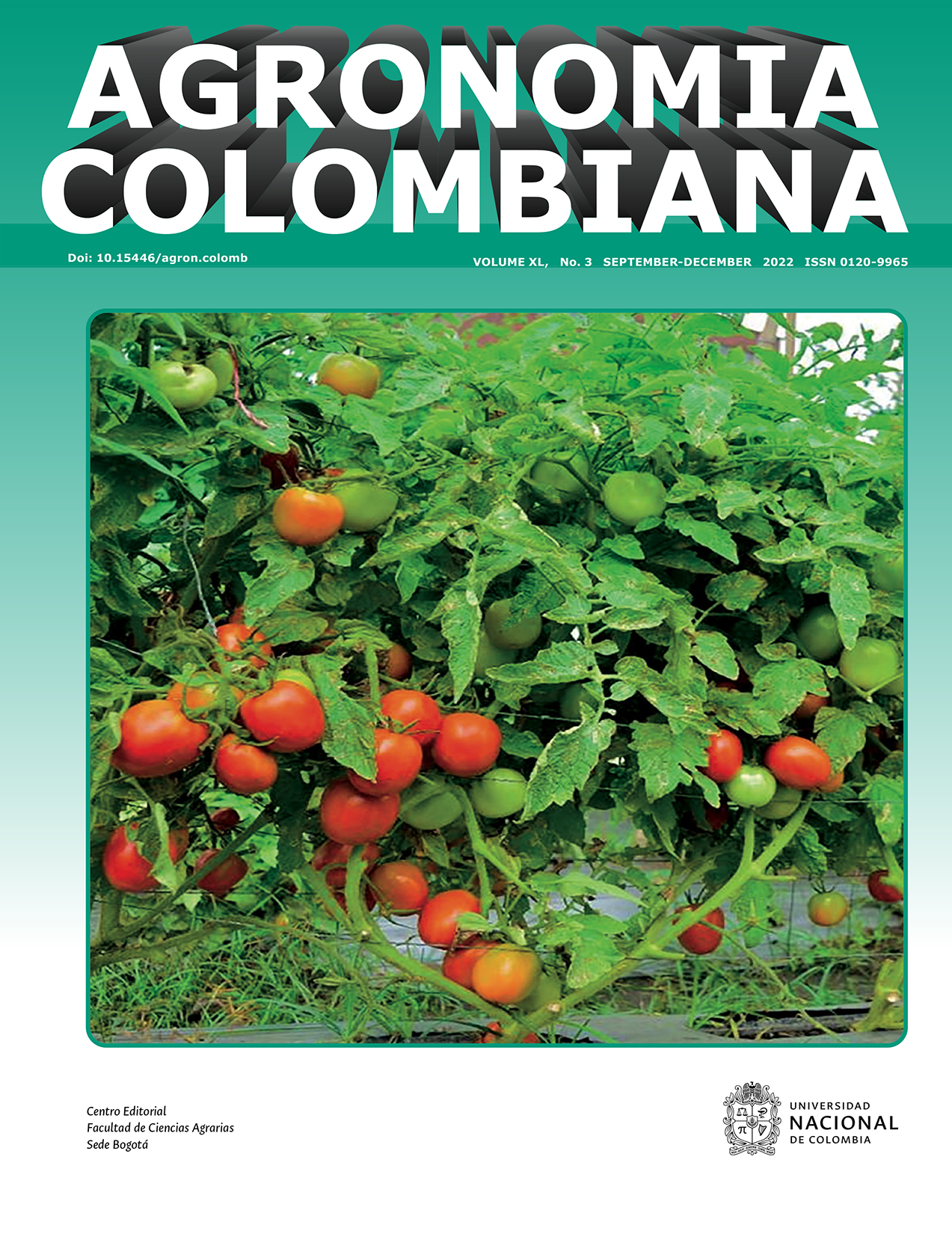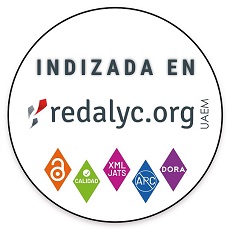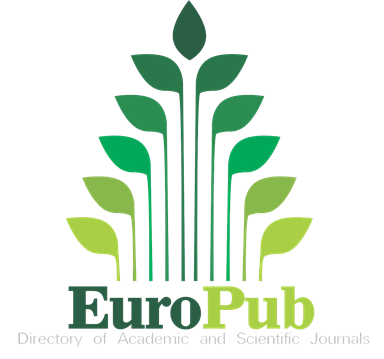Spectral behavior of banana with Foc R1 infection: Analysis of Williams and Gros Michel clones
Comportamiento espectral de banano con infección de Foc R1: análisis de clones Williams y Gros Michel
DOI:
https://doi.org/10.15446/agron.colomb.v40n3.103969Keywords:
early detection, spectrum, vascular disease, fungus, Fusarium wilt (en)detección temprana, espectro, enfermedad vascular, hongo, marchitez por Fusarium (es)
Downloads
Fusarium wilt is the greatest threat to Musaceae production worldwide; remote sensing techniques based on reflectance spectroscopy are proposed for its detection. The spectral response of leaves of healthy plants and plants infected with Fusarium oxysporum f. sp. cubense Race1 (Foc R1) from two banana cultivars during the incubation period of the disease were characterized. Spectra of 400-1000 nm were measured in healthy and Foc R1-infected plants on Gros Michel (GM: susceptible) and Williams (W: resistant) bananas with an Ocean Optics HR2000+ portable spectrometer. Similar general patterns were obtained in the spectra for both cultivars for the Vis, around 25% in the green region, but, as the foliar development progressed, reflectance decreased throughout the entire spectral range, close to 12.5% (green region of Vis range) on leaf 4 of both. Four wavelengths were discriminant for the healthy plants in the cultivars. Additionally, reflectance increased in the infected plants in the incubation period throughout the range, decreasing rapidly once the first visible symptoms appeared. The results suggested that an increase in reflectance at discriminating wavelengths can be used to diagnose diseased plants in the asymptomatic period, and a rapid decrease in this suggests the onset of the symptomatic phase.
La marchitez por Fusarium es la mayor amenaza para la producción mundial de musáceas, para su detección se proponen técnicas de detección remota basadas en espectroscopía de reflectancia. Se caracterizó la respuesta espectral de hojas de plantas sanas e infectadas con Fusarium oxysporum f. sp. cubense Raza1 (Foc R1) en dos cultivares de banano, durante el periodo de incubación de la enfermedad. Se midieron los espectros de 400-1000 nm en plantas sanas e infectadas con Foc R1 de banano Gros Michel (GM: susceptible) y Williams (W: resistente) con un espectrómetro portátil Ocean Optics HR2000+. Se obtuvieron patrones generales en los espectros similares para ambos cultivares en el Vis, alrededor del 25% en la región del verde, pero al avanzar el desarrollo foliar disminuyó la reflectancia en todo el rango espectral, cerca al 12.5% (región verde del rango Vis) en la hoja cuatro de ambos. Cuatro longitudes de onda fueron discriminantes para plantas sanas en los cultivares. Adicionalmente, la reflectancia aumentó en las plantas infectadas en el periodo de incubación en todo el rango, disminuyendo rápidamente una vez se presentaron los primeros síntomas visibles. Los resultados sugirieron que un aumento de la reflectancia en longitudes de onda discriminantes puede usarse para diagnosticar plantas enfermas en el periodo asintomático y una rápida disminución sugiere el inicio de la fase sintomática.
References
Abdulridha, J., Batuman, O., & Ampatzidis, Y. (2019). UAV-based remote sensing technique to detect citrus canker disease utilizing hyperspectral imaging and machine learning. Remote Sensing, 11(11), Article 1373. https://doi.org/10.3390/rs11111373 DOI: https://doi.org/10.3390/rs11111373
Abu-Khalaf, N., & Salman, M. (2014). Visible/Near infrared (VIS/ NIR) spectroscopy and multivariate data analysis (MVDA) for identification and quantification of olive leaf spot (OLS) disease. Palestine Technical University Research Journal, 2(1), 1–8. https://doi.org/10.53671/pturj.v2i1.21 DOI: https://doi.org/10.53671/pturj.v2i1.21
Barbedo, J. G. A. (2013). Digital image processing techniques for detecting, quantifying and classifying plant diseases. Springer-Plus, 2(1), Article 660. https://doi.org/10.1186/2193-1801-2-660 DOI: https://doi.org/10.1186/2193-1801-2-660
Berestetskiy, A. O. (2008). A review of fungal phytotoxins: from basic studies to practical use. Applied Biochemistry and Microbiology, 44(5), Article 453. https://doi.org/10.1134/s0003683808050013 DOI: https://doi.org/10.1134/S0003683808050013
Boyer, M., Miller, J., Belanger, M., Hare, E., & Wu, J. (1988). Senescence and spectral reflectance in leaves of northern pin oak (Quercus palustris Münchh.). Remote Sensing of Environment, 25(1), 71–87. https://doi.org/10.1016/0034-4257(88)90042-9 DOI: https://doi.org/10.1016/0034-4257(88)90042-9
Castañeda, C. S., Almanza-Merchán, P. J., Pinzón, E. H., Cely, G. E., & Serrano, P. A. (2018). Estimación de la concentración de clorofila mediante métodos no destructivos en vid (Vitis vinífera L.) cv. Riesling Becker. Revista Colombiana de Ciencias Hortícolas, 12(2), 329–337. https://doi.org/10.17584/rcch.2018v12i2.7566 DOI: https://doi.org/10.17584/rcch.2018v12i2.7566
Chaerle, L., & Van Der Straeten, D. (2000). Imaging techniques and the early detection of plant stress. Trends in Plant Science, 5(11), 495–501. https://doi.org/10.1016/s1360-1385(00)01781-7 DOI: https://doi.org/10.1016/S1360-1385(00)01781-7
Chalker-Scott, L. (1999). Environmental significance of anthocyanins in plant stress responses. Photochemistry and Photobiology, 70(1), 1–9. https://doi.org/10.1111/j.1751-1097.1999.tb01944.x DOI: https://doi.org/10.1111/j.1751-1097.1999.tb01944.x
Chuvieco, E. (2008). Teledetección ambiental. La observación de la tierra desde el espacio (3rd ed.). Ariel.
De Mendiburu, F. (2022, February). Agricolae: Statistical procedures for agricultural research. R v. 4.1. 2. http://cran.r-project.org/package=agricolae
Demmig‐Adams, B., Gilmore, A. M., & Adams III, W. W. (1996). In vivo functions of carotenoids in higher plants. The FASEB Journal, 10(4), 403–412. https://doi.org/10.1096/fasebj.10.4.8647339 DOI: https://doi.org/10.1096/fasebj.10.4.8647339
Dong, X., Xiong, Y., Ling, N., Shen, Q., & Guo, S. (2014). Fusaric acid accelerates the senescence of leaf in banana when infected by Fusarium. World Journal of Microbiology and Biotechnology, 30(4), 1399–1408. https://doi.org/10.1007/s11274-013-1564-1 DOI: https://doi.org/10.1007/s11274-013-1564-1
Dordas, C. (2008). Role of nutrients in controlling plant diseases in sustainable agriculture. A review. Agronomy for Sustainable Development, 28(1), 33–46. https://doi.org/10.1051/agro:2007051 DOI: https://doi.org/10.1051/agro:2007051
Dray, F. A., Center, T. D., & Mattison, E. D. (2012). In situ estimates of waterhyacinth leaf tissue nitrogen using a SPAD-502 chlorophyll meter. Aquatic Botany, 100, 72–75. https://doi.org/10.1016/j.aquabot.2012.03.005 DOI: https://doi.org/10.1016/j.aquabot.2012.03.005
Durgante, F. M., Higuchi, N., Almeida, A., & Vicentini, A. (2013). Species spectral signature: discriminating closely related plant species in the Amazon with near-infrared leaf-spectroscopy. Forest Ecology and Management, 291, 240–248. https://doi.org/10.1016/j.foreco.2012.10.045 DOI: https://doi.org/10.1016/j.foreco.2012.10.045
FAO (The Food and Agriculture Organization of the United Nations). (2020). Análisis del mercado del banano. Panorama general de febrero de 2020. http://www.fao.org/3/ca9212es/ca9212es.pdf
Feigin, A. M., Takemoto, J. Y., Wangspa, R., Teeter, J. H., & Brand, J. G. (1996). Properties of voltage-gated ion channels formed by syringomycin E in planar lipid bilayers. The Journal of Membrane Biology, 149(1), 41–47. https://doi.org/10.1007/s002329900005 DOI: https://doi.org/10.1007/s002329900005
Féret, J. B., Gitelson, A. A., Noble, S. D., & Jacquemoud, S. (2017). PROSPECT-D: towards modeling leaf optical properties through a complete lifecycle. Remote Sensing of Environment, 193, 204–215. https://doi.org/10.1016/j.rse.2017.03.004 DOI: https://doi.org/10.1016/j.rse.2017.03.004
García-Bastidas, F. A., Quintero-Vargas, J. C., Ayala-Vasquez, M., Schermer, T., Seidl, M. F., Santos-Paiva, M., Noguera, A. M., Aguilera-Galvez. C., Wittenberg, A., Hofstede, R., Sørensen, A., & Kema, G. H. J. (2020). First report of Fusarium wilt Tropical Race 4 in Cavendish bananas caused by Fusarium odoratissimum in Colombia. Plant Disease, 104(3), 994–994. https://doi.org/10.1094/pdis-09-19-1922-pdn DOI: https://doi.org/10.1094/PDIS-09-19-1922-PDN
Hatfield, J. L., Gitelson, A. A., Schepers, J. S., & Walthall, C. L. (2008). Application of spectral remote sensing for agronomic decisions. Agronomy Journal, 100(S3), S-117–S-131. https://doi.org/10.2134/agronj2006.0370c DOI: https://doi.org/10.2134/agronj2006.0370c
Jie, L., Zifeng, W., Lixiang, C., Hongming, T., Patrik, I., Zide, J., & Shining, Z. (2009). Artificial inoculation of banana tissue culture plantlets with indigenous endophytes originally derived from native banana plants. Biological Control, 51(3), 427–434. https://doi.org/10.1016/j.biocontrol.2009.08.002 DOI: https://doi.org/10.1016/j.biocontrol.2009.08.002
Lavermicocca, P., Iacobellis, N. S., Simmaco, M., & Graniti, A. (1997). Biological properties and spectrum of activity of Pseudomonas syringae pv. Syringaetoxins. Physiological and Molecular Plant Pathology, 50(2), 129–140. https://doi.org/10.1006/pmpp.1996.0078 DOI: https://doi.org/10.1006/pmpp.1996.0078
Li, M. H., Xie, X. L., Lin, X. F., Shi, J. X., Ding, Z. J., Ling, J. F., Xi, P. G., Zhou, J. N., Leng, Y., Zhong, S., & Jiang, Z. D. (2014). Functional characterization of the gene FoOCH1 encoding a putative α-1, 6-mannosyltransferase in Fusarium oxysporum f. sp. Cubense. Fungal Genetics and Biology, 65, 1–13. https://doi.org/10.1016/j.fgb.2014.01.005 DOI: https://doi.org/10.1016/j.fgb.2014.01.005
Mahlein, A. K. (2016). Plant disease detection by imaging sensors – parallels and specific demands for precision agriculture and plant phenotyping. Plant Disease, 100(2), 241–251. https://doi.org/10.1094/pdis-03-15-0340-fe DOI: https://doi.org/10.1094/PDIS-03-15-0340-FE
Mahlein, A. K., Rumpf, T., Welke, P., Dehne, H. W., Plümer, L., Steiner, U., & Oerke, E. C. (2013). Development of spectral indices for detecting and identifying plant diseases. Remote Sensing of Environment, 128, 21–30. https://doi.org/10.1016/j.rse.2012.09.019 DOI: https://doi.org/10.1016/j.rse.2012.09.019
Marín, J. C., Hoyos-Carvajal, L., & Botero-Fernández, V. (2018). Detección de plantas asintomáticas de Solanum lycopersicum L. infectadas con Fusarium oxysporum usando espectroscopia de reflectancia VIS. Revista Colombiana de Ciencias Hortícolas, 12(2), 436–446. https://doi.org/10.17584/rcch.2018v12i2.7293 DOI: https://doi.org/10.17584/rcch.2018v12i2.7293
Martinelli, F., Scalenghe, R., Davino, S., Panno, S., Scuderi, G., Ruisi, P., Villa, P., Stroppiana, D., Boschetti, M., Goulart, L. R., Davis, C. E., & Dandekar, A. M. (2015). Advanced methods of plant disease detection. A review. Agronomy for Sustainable Development, 35(1),1–25. https://doi.org/10.1007/s13593-014-0246-1 DOI: https://doi.org/10.1007/s13593-014-0246-1
Martínez, R., & Solís, G. A. (2018). Caracterización espectral y detección de flecha seca en palma africana en Puntarenas, Costa Rica. Revista Geográfica de América Central, 2(61), 349–377. https://doi.org/10.15359/rgac.61-2.13 DOI: https://doi.org/10.15359/rgac.61-2.13
Maryani, N., Lombard, L., Poerba, Y. S., Subandiyah, S., Crous, P. W., & Kema, G. H. J. (2018). Phylogeny and genetic diversity of the banana Fusarium wilt pathogen Fusarium oxysporum f. sp. cubense in the Indonesian centre of origin. Studies in Mycology, 91(1), 79–99. https://doi.org/10.1016/j.simyco.2018.06.003 DOI: https://doi.org/10.1016/j.simyco.2018.06.003
Mather, P. (2004). Computer processing of remotely-sensed images (2nd ed.). John Wiley & Sons.
Mather, P., & Koch, M. (2011). Pre-processing of remotely-sensed data. In P. Mather, & M. Koch, Computer processing of remotely-sensed images: An introduction (4th ed., pp. 87–124). John Wiley & Sons. https://doi.org/10.1002/9780470666517.ch4 DOI: https://doi.org/10.1002/9780470666517.ch4
Pérez Vicente, L. F., Dita, M., & Martinez De La Parte, E. (2014). Technical manual: Prevention and diagnostic of Fusarium wilt (Panama disease) of banana caused by Fusarium oxysporum f. sp. cubense Tropical Race 4 (TR4). FAO.
Pimentel, D. (2011). Biological invasions: economic and environmental costs of alien plant, animal, and microbe species (2nd ed). CRC Press. DOI: https://doi.org/10.1201/b10938
Pivonia, S., Cohen, R., Katan, J., & Kigel, J. (2002). Effect of fruit load on the water balance of melon plants infected with Monosporascus cannonballus. Physiological and Molecular Plant Pathology, 60(1), 39–49. https://doi.org/10.1006/pmpp.2001.0375 DOI: https://doi.org/10.1006/pmpp.2001.0375
Ploetz, R. C. (2006). Fusarium wilt of banana is caused by several pathogens referred to as Fusarium oxysporum f. sp. cubense. Phytopathology, 96(6), 653–656. https://doi.org/10.1094/phyto-96-0653 DOI: https://doi.org/10.1094/PHYTO-96-0653
Ratnadass, A., Fernandes, P., Avelino, J., & Habib, R. (2012). Plant species diversity for sustainable management of crop pests and diseases in agroecosystems: a review. Agronomy for Sustainable Development, 32(1), 273–303. https://doi.org/10.1007/s13593-011-0022-4 DOI: https://doi.org/10.1007/s13593-011-0022-4
Rizzo, D. M., Lichtveld, M., Mazet, J. A., Togami, E., & Miller, S. A. (2021). Plant health and its effects on food safety and security in a one health framework: Four case studies. One Health Outlook, 3(1), 1–9. https://doi.org/10.1186/s42522-021-00038-7 DOI: https://doi.org/10.1186/s42522-021-00038-7
Sanger, J. E. (1971). Quantitative investigations of leaf pigments from their inception in buds through autumn coloration to decomposition in falling leaves. Ecology, 52(6), 1075–1089. https://doi.org/10.2307/1933816 DOI: https://doi.org/10.2307/1933816
Sankaran, S., Mishra, A., Ehsani, R., & Davis, C. (2010). A review of advanced techniques for detecting plant diseases. Computers and Electronics in Agriculture, 72(1), 1–13. https://doi.org/10.1016/j.compag.2010.02.007 DOI: https://doi.org/10.1016/j.compag.2010.02.007
Silva-Perez, V., Molero, G., Serbin, S. P., Condon, A. G., Reynolds, M. P., Furbank, R. T., & Evans, J. R. (2018). Hyperspectral reflectance as a tool to measure biochemical and physiological traits in wheat. Journal of Experimental Botany, 69(3), 483–496. https://doi.org/10.1093/jxb/erx421 DOI: https://doi.org/10.1093/jxb/erx421
Sinha, P., Robson, A., Schneider, D., Kilic, T., Mugera, H. K., Ilukor, J., & Tindamanyire, J. M. (2020). The potential of in-situ hyperspectral remote sensing for differentiating 12 banana genotypes grown in Uganda. ISPRS Journal of Photogrammetry and Remote Sensing, 167, 85–103. https://doi.org/10.1016/j.isprsjprs.2020.06.023 DOI: https://doi.org/10.1016/j.isprsjprs.2020.06.023
Sohn, S. I., Oh, Y. J., Pandian, S., Lee, Y. H., Zaukuu, J. L. Z., Kang, H. J., Ryu, T. H., Cho, W. S., Cho, Y. S., & Shin, E. K. (2021). Identification of Amaranthus species using Visible-Near-Infrared (Vis-NIR) spectroscopy and machine learning methods. Remote Sensing, 13(20), Article 4149. https://doi.org/10.3390/rs13204149 DOI: https://doi.org/10.3390/rs13204149
Szuvandzsiev, P., Helyes, L., Lugasi, A., Szántó, C., Baranowski, P., & Pék, Z. (2014). Estimation of antioxidant components of tomato using VIS-NIR reflectance data by handheld portable spectrometer. International Agrophysics, 28(4), 521–527. https://doi.org/10.2478/intag-2014-0042 DOI: https://doi.org/10.2478/intag-2014-0042
Thomas, S., Kuska, M. T., Bohnenkamp, D., Brugger, A., Alisaac, E., Wahabzada, M., Behamnn, J., & Mahlein, A. K. (2018). Benefits of hyperspectral imaging for plant disease detection and plant protection: a technical perspective. Journal of Plant Diseases and Protection, 125(1), 5–20. https://doi.org/10.1007/s41348-017-0124-6 DOI: https://doi.org/10.1007/s41348-017-0124-6
Varma, V., & Bebber, D. P. (2019). Climate change impacts on banana yields around the world. Nature Climate Change, 9(10), 752–757. https://doi.org/10.1038/s41558-019-0559-9 DOI: https://doi.org/10.1038/s41558-019-0559-9
Verrelst, J., Camps-Valls, G., Muñoz-Marí, J., Rivera, J. P., Veroustraete, F., Clevers, J. G., & Moreno, J. (2015). Optical remote sensing and the retrieval of terrestrial vegetation bio-geophysical properties – A review. ISPRS Journal of Photogrammetry and Remote Sensing, 108, 273–290. https://doi.org/10.1016/j.isprsjprs.2015.05.005 DOI: https://doi.org/10.1016/j.isprsjprs.2015.05.005
Wang, D., Peng, C., Zheng, X., Chang, L., Xu, B., & Tong, Z. (2020). Secretome analysis of the banana Fusarium wilt fungi Foc R1 and Foc TR4 reveals a new effector OASTL required for full pathogenicity of Foc TR4 in banana. Biomolecules, 10(10), Article 1430. https://doi.org/10.3390/biom10101430 DOI: https://doi.org/10.3390/biom10101430
Young, A. J., & Britton, G. (1990). Carotenoids and oxidative stress. In M. Baltscheffsky (Ed.), Current research in photosynthesis (pp. 3381–3384). Springer. https://doi.org/10.1007/978-94-009-0511-5_759 DOI: https://doi.org/10.1007/978-94-009-0511-5_759
Zhang, J., Huang, Y., Pu, R., Gonzalez-Moreno, P., Yuan, L., Wu, K., & Huang, W. (2019). Monitoring plant diseases and pests through remote sensing technology: A review. Computers and Electronics in Agriculture, 165, Article 104943. https://doi.org/10.1016/j.compag.2019.104943 DOI: https://doi.org/10.1016/j.compag.2019.104943
Zhang, J., Pu, R., Huang, W., Yuan, L., Luo, J., & Wang, J. (2012). Using in-situ hyperspectral data for detecting and discriminating yellow rust disease from nutrient stresses. Field Crops Research, 134, 165–174. https://doi.org/10.1016/j.fcr.2012.05.011 DOI: https://doi.org/10.1016/j.fcr.2012.05.011
How to Cite
APA
ACM
ACS
ABNT
Chicago
Harvard
IEEE
MLA
Turabian
Vancouver
Download Citation
License

This work is licensed under a Creative Commons Attribution-NonCommercial-ShareAlike 4.0 International License.
© Centro Editorial de la Facultad de Ciencias Agrarias, Universidad Nacional de Colombia
Reproduction and quotation of material appearing in the journal is authorized provided the following are explicitly indicated: journal name, author(s) name, year, volume, issue and pages of the source. The ideas and observations recorded by the authors are their own and do not necessarily represent the views and policies of the Universidad Nacional de Colombia. Mention of products or commercial firms in the journal does not constitute a recommendation or endorsement on the part of the Universidad Nacional de Colombia; furthermore, the use of such products should comply with the product label recommendations.
The Creative Commons license used by Agronomia Colombiana journal is: Attribution - NonCommercial - ShareAlike (by-nc-sa)

Agronomia Colombiana by Centro Editorial of Facultad de Ciencias Agrarias, Universidad Nacional de Colombia is licensed under a Creative Commons Reconocimiento-NoComercial-CompartirIgual 4.0 Internacional License.
Creado a partir de la obra en http://revistas.unal.edu.co/index.php/agrocol/.





















